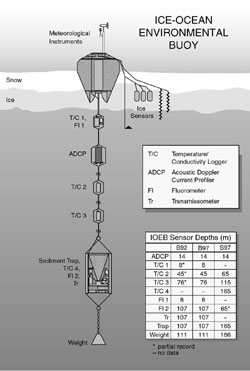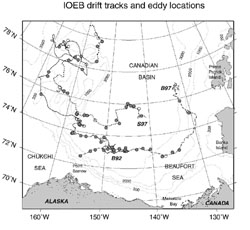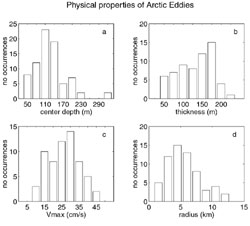|
Eddies in the Beaufort Gyre
A.
Plueddemann
Associate Scientist, WHOI
Supported by: National Science Foundation Office of Polar
Programs
This project used observations of velocity in the western
Arctic pycnocline (25-300~m depth) made with Acoustic Doppler Current Profilers
(ADCPs) to investigate the distribution and properties of subsurface eddies. The
ADCPs were deployed on autonomous drifters called, Ice Ocean Environmental Buoys
(IOEBs), that were frozen into the pack ice (Figure 1).
Data were available from three IOEB deployments within the
Beaufort Gyre between 1992 and 1998. Ninety five probable eddy encounters were
identified during the four IOEB deployments, which included 44 months of buoy
drift. Physical properties were determined for 62 encounters in a series of
steps, the most important of which was estimating the eddy center. The typical
eddy encounter rate was 1 per 100 km of drift (Figure
2). The highest encounter rate was in the Canada Basin, but a significant
number of eddies were also found to the west of the basin, over the Chukchi
Plateau.
The number of eddies with reliable physical property estimates
was sufficient to generate meaningful statistics of eddy size, strength, and
vertical structure (Figure 3). The majority of
center depths were between 90 and 160~m and the mean vertical extent was 130~m.
Thus, eddies were found predominantly within the cold halocline. Maximum
rotation speeds were typically 20-35 cm/s, with some greater than 40 cm/s.
Typical radii were 3-8 km. Faster rotation speeds were associated with larger
vertical extent and larger radius. The sense of rotation was predominantly
anticyclonic.
Dynamical properties were determined for 22 eddies. Tangential
velocity increased nearly linearly within the eddy core (i.e. out to the radius
of maximum velocity). Velocity decay in the eddy periphery was rapid, with
values approaching background velocities within 2.5 times the radius of maximum
velocity. Relative vorticity was maximum in the eddy core, with values nearly
equal and opposite to the local planetary vorticity. Strain was largest outside
the radius of maximum velocity. These results are consistent with isolated
eddy cores in approximate solid body rotation.
|










